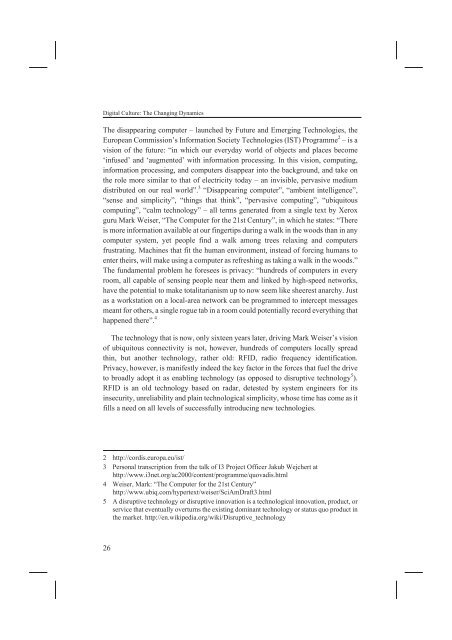D:\Documents and Settings\Ana\My Documents\Biserka-knjiga ...
D:\Documents and Settings\Ana\My Documents\Biserka-knjiga ...
D:\Documents and Settings\Ana\My Documents\Biserka-knjiga ...
Create successful ePaper yourself
Turn your PDF publications into a flip-book with our unique Google optimized e-Paper software.
Digital Culture: The Changing Dynamics<br />
The disappearing computer – launched by Future <strong>and</strong> Emerging Technologies, the<br />
European Commission’s Information Society Technologies (IST) Programme 2 – is a<br />
vision of the future: “in which our everyday world of objects <strong>and</strong> places become<br />
‘infused’ <strong>and</strong> ‘augmented’ with information processing. In this vision, computing,<br />
information processing, <strong>and</strong> computers disappear into the background, <strong>and</strong> take on<br />
the role more similar to that of electricity today – an invisible, pervasive medium<br />
distributed on our real world”. 3 “Disappearing computer”, “ambient intelligence”,<br />
“sense <strong>and</strong> simplicity”, “things that think”, “pervasive computing”, “ubiquitous<br />
computing”, “calm technology” – all terms generated from a single text by Xerox<br />
guru Mark Weiser, “The Computer for the 21st Century”, in which he states: “There<br />
is more information available at our fingertips during a walk in the woods than in any<br />
computer system, yet people find a walk among trees relaxing <strong>and</strong> computers<br />
frustrating. Machines that fit the human environment, instead of forcing humans to<br />
enter theirs, will make using a computer as refreshing as taking a walk in the woods.”<br />
The fundamental problem he foresees is privacy: “hundreds of computers in every<br />
room, all capable of sensing people near them <strong>and</strong> linked by high-speed networks,<br />
have the potential to make totalitarianism up to now seem like sheerest anarchy. Just<br />
as a workstation on a local-area network can be programmed to intercept messages<br />
meant for others, a single rogue tab in a room could potentially record everything that<br />
happened there”. 4<br />
The technology that is now, only sixteen years later, driving Mark Weiser’s vision<br />
of ubiquitous connectivity is not, however, hundreds of computers locally spread<br />
thin, but another technology, rather old: RFID, radio frequency identification.<br />
Privacy, however, is manifestly indeed the key factor in the forces that fuel the drive<br />
to broadly adopt it as enabling technology (as opposed to disruptive technology 5 ).<br />
RFID is an old technology based on radar, detested by system engineers for its<br />
insecurity, unreliability <strong>and</strong> plain technological simplicity, whose time has come as it<br />
fills a need on all levels of successfully introducing new technologies.<br />
2 http://cordis.europa.eu/ist/<br />
3 Personal transcription from the talk of I3 Project Officer Jakub Wejchert at<br />
http://www.i3net.org/ac2000/content/programme/quovadis.html<br />
4 Weiser, Mark: “The Computer for the 21st Century”<br />
http://www.ubiq.com/hypertext/weiser/SciAmDraft3.html<br />
5 A disruptive technology or disruptive innovation is a technological innovation, product, or<br />
service that eventually overturns the existing dominant technology or status quo product in<br />
the market. http://en.wikipedia.org/wiki/Disruptive_technology<br />
26



